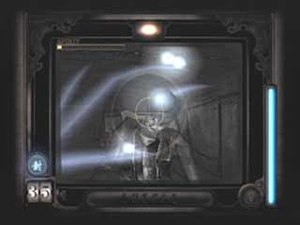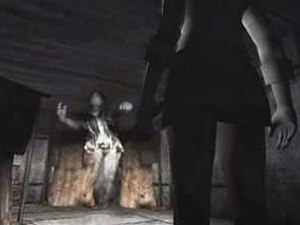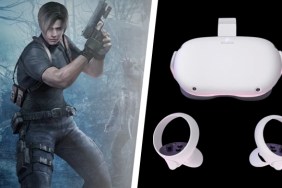Death by exposure.
The photographic process practically celebrates (and gleefully vilifies) itself
within the horror genre. Spooky images on film and video like this
and this but probably not this
– already once-removed from direct human experience – are somehow creepier in
and of themselves because of that very inherent connection to, and disconnection
from, what we laughingly call “reality.” It’s exactly this sort of unease that
fueled The Blair Witch Project and a number of rather unpleasant camera-related
moments in David Lynch’s film Lost Highway, as well as Clive Barker’s disturbing
short story “Dread.”
The
minds behind Fatal Frame clearly grasp the disturbing disconnect the
camera eye can force us to experience. Japanese games have a well-established
history of magnifying that sort of tweaky unease to begin with…and what could
be more consummately Japanese than a survival-horror game in which the short-skirted
schoolgirl protagonist constantly takes pictures of everything with her little
camera? All righty, then.
Fatal Frame looks more or less like your typical cinematic spooky game
at first glance. It puts you in the shoes of a young Japanese girl named Miku,
searching for your missing brother and trapped in a mansion haunted by way too
many restless ghosts. You control Miku (who actually looks Japanese,
for a change) from the expected ominous camera angles, and repeatedly go rooting
around through inventory and map screens.
Sounds like old-school survival horror stuff, right? Except there’s a very
definite catch – Miku’s ‘weaponry’ consists of a special camera, through whose
use she can exorcise the spirits of the departed. While the player controls
Miku through a standard third-person cinematic viewpoint (as in, say, Resident
Evil or Silent Hill), the angry dead in
Fatal Frame must be confronted in a first-person viewpoint, through
the camera lens. It’s a small but ingenious caveat that at times almost
gives the game the immediacy of a first-person shooter
This effectively results in two major kinds of supernatural combat. There’s
the kind where some ghastly thing suddenly materializes right behind you in
the third-person view (and scares the living @#$%! out of you until you manage
to fumble the camera up to your eye and counterattack it). Then there’s the
kind where you constantly sweep the room in first-person mode, with the camera
glued to your paranoid eye at all times, until said Ghastly Thing suddenly materializes
right in front of you (and scares the living @#$%! out of you until you manage
to F-stop the thing into screaming submission). Either way you choose to play
it, Fatal Frame is a very well-produced and creepy game with the most
cinematically-grounded mindset I’ve seen thus far in a video game.
Fatal Frame‘s introduction, which is playable, also serves as a tutorial.
It shows us Miku’s missing brother on his own quest to locate a famous author
(himself gone AWOL in the sprawling mansion). The entire sequence has the creepy,
grainy-film look of a bad memory revisited, complete with a subtle, disturbing
filter effect that fools the eyes into looking for things that aren’t there.
It definitely falls under the heading of a “trick” on the player…but it’s
a really good trick, and does a lot toward instantly establishing the proper
mood.
Once the “real” game starts, Miku is forced to walk through the same
initial rooms the (presumably doomed) brother just moved through. It’s an old
Hollywood suspense-building gambit unofficially called “Don’t go in there, we
just saw [insert other person’s name] eat it in the exact same place!” and it
works beautifully. Fatal Frame‘s overall “camerawork” is superb, calculated
for maximum effect. If you take your spooky games at all seriously, you owe
it to yourself to play it alone, in the dark, with the sound turned up.
Mechanically, camera-combat is a, ahem, snap. When a ghost appears near Miku, a quick press of the circle button brings up a first-person camera lens viewpoint. The left thumbstick moves the camera around while the right thumbstick allows Miku to move while keeping the target in-frame. The longer the spirit is kept in the photographic kill-zone, the more said spirit is damaged when the shot is finally taken. It’s pretty straightforward, but it’s creepy, too. Fatal Frame’s ghosts make ugly faces and ugly noises, warping into existence right beside you or in front of you and often rematerializing from point to point as you frantically try to keep a first-person bead on them, and all the while they’re howling distorted cries like “Let me out!” and “Give back my child!”
I’ve heard some complaints that the voice work is too repetitive, but it seems like a pretty pointless point to me. If a ghost gets to scream the same line at you more than a few times per encounter, it probably means you’re a lousy ghost-buster and you’re about to be killed anyway.
If the spirits manage to dodge your attacks and get their ghostly hooks into Miku personally, the video (and even the audio) melts and distorts as they choke the life out of her. It’s true that there’s only so much one can do on the flat screen, but it’s one of the most disturbing effects you’ll currently find in PS2 title.
The game’s design team has claimed more than once that Fatal Frame
conveys better than any other game the presence of supernatural forces in the
room, which is true and fair enough. Far be it from a mere critic of the arts
to suggest that it also depicts the presence of some fairly serious pharmaceuticals
on the design team’s nightstand. Hey, whatever gets the job done.
 In
In
addition to the purely visual creeps, Fatal Frame conveys Miku’s psychic
sensitivity by having the controller throb her heartbeat into the player’s hands
whenever something occultically-noteworthy is nearby. It’s almost too much help
at times, but it sure piles up the fear-factor.
My favorite Fatal Frame anecdote comes from a buddy we’ll call “John.”
John, a seasoned gamer who’d prefer to come off as rather a hardcase than not,
popped Fatal Frame into his PS2 on my recommendation one bright, sunny
day at his office around mid-afternoon…and purportedly yelled “Jesus!” and
damn-near dropped the controller the first time one of FF‘s ghosts crossed
his path. It made me feel much better about my own first crack at the game which
was, of course, in a dark room at around midnight. Now let us never speak of
this again.
The mechanics that compose the rest of the game will be instantly familiar
to anyone who’s played a survival-horror game; at times, a bit too familiar.
Film types of various grades for the camera serve as ‘ammunition,’ with varying
grades of performance, and door/mechanism/item-fetch puzzles are the norm. The
game’s backstory is filled in through the notebook scraps, audio tapes and other
physical clues to be found throughout the mansion.
Fatal Frame‘s problems are minor. The first you’ll likely encounter
is that the game-save file is so darn big – forget about keeping a Fatal
Frame save on the same card as ten other game-saves like you’re probably
used to. Also, the camera’s targeting scheme is adamant about getting foes within
the glowing Capture Circle. It does not matter how up-close-and-personal you
get with the attacking entities (as evidenced by the 24 photos per game you
can save in a dedicated ‘album’) – you’ll occasionally be awarded no points
for a frighteningly-close call, even though the developed film clearly shows
the otherworldly aggressor filling the frame.
And though it certainly breaks new ground with its emphasis on sheer frights
and disturbing imagery, Fatal Frame relies very heavily on ubiquitous
survival-horror gameplay elements. Hope you like your silly puzzles.
If you’re one of those gamers with a predilection for The Creeps – you know
who you are – Fatal Frame is simply a must-see. Easily-freaked and superstitious
types may not make it all the way through, as was the case for many a Silent
Hill player. No shame in being sensitive. For the full experience, you hard-core
types could even play Fatal Frame alone, in the dark, with a high fever
and a Ouija board nearby for handy “off-line help.” You could…but it doesn’t
sound like a good idea.

-
Excellent production values
-
Camera use keeps player paranoid
-
Japanese characters actually look Japanese!
-
'Sixth Sense' too helpful
-
Apparent visual 'hits' will sometimes not yield points







